calsfoundation@cals.org
Arachnids
Arachnids belong to Chelicerata, one of four groups of living arthropods. The other three groups are Crustacea, Myriapoda (centipedes and millipedes), and Hexapoda (insects and relatives). There are eleven living arachnid orders, and Arkansas has representatives of five of these including Scorpiones (scorpions), Pseudoscorpiones (pseudoscorpions), Opiliones (harvestmen), Aranea (spiders), and Acari (mites).
Overview of Arachnids
Arachnid bodies are divided into two main regions called the prosoma (cephalothorax) and opisthosoma (abdomen). These regions have been subdivided in some groups (e.g., solifugids, scorpions). The prosoma holds six pairs of appendages. Unlike in all other arthropods, the first appendages in chelicerates are not sensory antennae but pincer-like mouthparts known as chelicerae (hence the subphylum name). Behind the chelicerae, there are two pedipalps that can be significantly modified among different orders. Finally, arachnids generally have four pairs of legs, but larval ricinuleids and mites have six legs. Most arachnid generalizations (and animal generalizations, for that matter) can be broken by at least one mite species. So while mites have a maximum of six legs as larvae and eight legs as adults, some mites have secondarily lost leg pairs, so there are examples of mites with all known combinations from eight pairs of legs to none.
Most arachnids, and chelicerates in general, are predacious and have developed a multitude of strategies for catching prey. Additionally, extant arachnids are generally terrestrial, found in every conceivable habitat on land. However, mites range in their eating habits from the classic predators to a multitude of parasites, fungivores, and phytophages that often reach pest status, and they have thousands of species secondarily invading freshwater and marine habitats.
Scorpions and Pseudoscorpions
Scorpiones is represented in Arkansas by only one species, Centruroides vittatus (striped bark scorpion). Scorpions have modified pedipalps that form the pinchers used to grasp prey. Additionally, their opisthosoma is subdivided, the latter half extending into a tail-like structure terminating in a stinger capable of injecting venom into its victims. The anal opening is at the tip of its tail, just beneath the stinger. The sting of C. vitattus is not of medical importance.
Pseudoscorpions are abundant inhabitants of soil and litter communities in forests and can be collected under bark or rocks, within rock fractures, and in caves. Individuals are small, generally between two and eight millimeters long, and superficially resemble tiny, tailless scorpions. Some species (e.g., Chelifer cancroides) are commonly found in houses and feed on urban pests such as mites, springtails, cloths moth larvae, and booklice. Pseudoscorpion pedipalps are modified into pinchers capable of injecting venom to immobilize prey. Both scorpions and psuedoscorpions are excellent mothers. Pseudoscorpion mothers house fertilized eggs under her abdomen, and the young crawl on her back, protected, for the first instar or so. Pseudoscorpions can live many years (five to ten) and can have multiple broods in a year.
Unfortunately, adequate survey information does not exist for pseudoscorpions of Arkansas (or North America in general). There are roughly twenty species recorded from the state, three of which are troglobites (living entirely in caves). This is certainly an underestimate of the true diversity in the state, as Illinois, for example, has greater than thirty species. There are two Arkansas endemics (collected only in the state), and both are troglobites: Apochthonius diabolus and Apochthonius titanicus.
Harvestmen
Unlike pseudoscorpions, harvestmen are better known both to the layperson and the scientific community. Many people refer to them as “daddy-long-legs” or “granddaddy-long-legs,” though these terms also potentially refer to a family of true spiders (Pholcidae). Popular misinformation suggests these creatures are quite poisonous but have mouthparts too small to bite humans. This is false, as they completely lack venom glands. Opilionids are surprisingly morphologically diverse. Some individuals have well-developed eyes (Caddidae), while others look very much like mites (Cyphophthalmi), and members of Laniatores and Dyspnoi are diverse lineages with highly varied body shapes and adaptations. Even with Arkansas fauna, there is a considerable degree of morphological diversity. Opilionids are divided into three major groups, traditionally assigned to the level of suborder: Cyphophthalmi (mite-like harvestmen), Laniatores, and Palpatores. The latter are divided into Dyspnoi and Eupnoi. Almost all frequently encountered harvestmen are eupnoids (“daddy-long-legs”), and most studies and general knowledge pertain to Leiobunum, the common genus one is likely to encounter.
Harvestmen are generally opportunistic feeders, preying on small, soft-bodied animals or scavenging on dead animals, though some regularly take vegetable material. Most opilionids have a shortened abdomen broadly joined to the cephalothorax. Legs can be quite long, especially in Eupnoi (hence “daddy-long-legs”). Mating behavior can be very elaborate, and even seemingly romantic, and there is often a great degree of parental care. Males are equipped with an extrusible penis for internal fertilization, making them unique among arachnids.
State records for opilionid species are virtually non-existent nationwide, with Arkansas as no exception. While some groups are widely acknowledged to occur in Arkansas, like Leiobunum (Eupnoi: Sclerosomatidae), Eumesosoma (Eupnoi: Sclerosomatidae), Phalangium (Eupnoi: Phalangiidae), Odiellus (Eupnoi: Phalangiidae), and Vonones (Laniatores: Cosmetidae), others are frequently collected but rarely documented, such as Erebomaster (Laniatores: Cladonychiidae). In fact, Erebomaster may often be misidentified as Crosbyella (Laniatores: Phalangodidae). Crosbyella distincta and Crosbyelle roeweri are both known only from single caves in Arkansas. Sabacon cavicolens (Dyspnoi: Saboconidae) is also found in Arkansas caves, but can be found in other states as well.
Spiders
Spiders are the most commonly encountered arachnids. They are typically found in houses and are dominant predators in natural ecosystems. Obvious morphological structures are the constriction between the prosoma and opisthosoma (called a pedicel) and modified appendages on the abdomen used to disperse silk (spinnerets); the immovable digits on the chelicerae have become reduced, while the movable digit is sharpened into a fang. Unlike most other arachnids, they have lost segmentation on their opisthosoma, except for primitive lineages that have remnant abdominal plates signifying ancient segmentation.
Almost all spiders are capable of injecting venom via fangs. Only a few, small families lack venom glands, one occurring in North America (Uloboridae) and another primitive family in southeastern Asia (Liphistiidae). That said, only a few species of venomous spiders are capable of harming humans in any medically relevant way, including widow spiders (Latrodectus), recluse spiders (Loxosceles), hobo spiders (Tegenaria agrestis), and some sac spiders (Cheiracanthium). Hobo spiders are not found in Arkansas, and Cheiracanthium is a minor threat at best. Widow spiders should be respected, especially regarding children or pets, but are almost never life threatening to adults. Recluse spiders are subject to misinformation of mythical proportions and are certainly not the danger most people suspect, though the bite can be painful.
North American spiders are divided into two main groups: Mygalomorphae and Araneomorphae. Most spiders are araneomorphs (possessing fangs that slant toward each other), especially those most frequently encountered. Mygalomorphs (possessing fangs that point straight down) include tarantulas, trap-door spiders, and their relatives. Arkansas has three mygalomorph families, with five species total. Four species of Arkansas mygalomorphs are trap-door spiders (Ctenizidae and Antrodiaetidae) and the fifth is Aphonopelma hentzi, a true tarantula (Theraphosidae). Aphonopemla hentzi was studied by William Baerg (1885–1980), the father of American tarantula research, who also studied many other underrepresented groups. The distribution of these spiders was studied by the Arkansas Tarantula Survey, which found them throughout the state, except in the eastern Mississippi Alluvial Plain (Delta). A few records were found on Crowley’s Ridge, indicating that this region may hold other important indicator species.
Mites
By far, the most diverse arachnid group is Acari. Mites have exploited a huge range of habitats (temperate forests, tropical rainforests, deserts, arctic tundra, fresh water, and oceans) and display an even more impressive diversity of life-history strategies. Mites play important ecological roles in nature as well as being significant pests, predators, and disease vectors from agricultural, medical, and veterinary systems. Their small size and evolutionarily plastic body plan have allowed repeated radiations from predatory, free-living ancestors into exploitative niches such as ecto- and endoparasitism, obligate fungivory, and phytophagy. Despite a few spiders and opilionids that facultatively feed on non-animal matter, these strategies are unique among Chelicerata.
The extreme diversity of mites makes summarizing their biology difficult. Generally, mites have a fused cephalothorax and abdomen (idiosoma), and their mouthparts are grouped into a unified structure called a gnathosoma. Thus, when people refer to the “head” of a tick, they are actually just pointing out the mouthparts (gnathosoma). Mites develop from eggs as larvae and normally have several nymphal stages before reaching adulthood. Fertilization is usually external, and there have been many parthenogenetic species documented (that is, species whose eggs do not require fertilization).
Ticks are probably the best-known mites, commonly found as an irritant on either pets or humans. They are parasites of birds, mammals, reptiles, and even amphibians. Humans commonly encounter eight to ten of the more than 900 species. Tick studies in Arkansas have revealed that dogs can be infested by at least five tick species over a year, including the brown dog tick (Rhipicephalus sanguineus), the lone star tick (Amblyomma americanum), the Gulf Coast tick (Amblyomma maculatum), the American dog tick (Dermacentor variabilis), the blacklegged tick (Ixodes scapularis), and a few other species of Amblyomma and Ixodes. Tick infestations of cats are less studied, though cats are not generally considered to be good tick hosts due to their efficient grooming activities.
In Arkansas, cases of tick-borne diseases are on the rise in the twenty-first century. These diseases include spotted fevers (such as Rocky Mountain spotted fever), ehrlichias, and borrelias (e.g., Lyme disease). Ongoing research by entomologists at the University of Arkansas (UA) in Fayetteville (Washington County) shows that as many as twenty-five percent of Arkansas ticks harbor at least one of these pathogens. Tick removal and acaricide (tick/mite killing chemicals) treatments to both animals and indoor/outdoor environments may be necessary where infestation pressure is local and constant.
There are a multitude of other parasitic species, ranging from scabies mites, cat ear mites, and one genus that lives in the pores of the human face (Demodex), to nasal parasites on frogs and birds; respiratory mites in slugs, bees, and fish; and ectoparasites on millipedes, bat wings, bird feathers, mussels, insects, and salamanders. One example is bird nest mites, which feed on the blood of nestlings and their mother.
Less well known, but equally diverse, are the myriad soil species, ranging from specialized predators to worm-like creatures pushing their way through the deep soil. There are also large, tank-like detritivores often with extremely potent toxins and occasionally brightly colored fungal feeders. All of these are intimately involved in dynamic soil processes and aid in the breakdown of forest litter.
Velvet mites are another well-known group, often being very large and bright red. While velvet mite adults are lumbering predators, larvae are parasitic on other animals such as other arthropods and vertebrates. Some of these, whose primary hosts are small reptiles and mammals, are the pests known as “chiggers.” A common misconception is that chiggers burrow into one’s skin and remain for days or weeks. Instead, because humans are not the correct host, they drop off within hours, long before symptoms ever begin.
Water mites are amazing creatures that can be spectacularly colored. Like velvet mites, they are predacious as adults but parasitic as larvae. They generally parasitize aquatic insects, but some groups attack mussels and salamanders. Water mites, like most mites, are vastly understudied, though studies conducted at UA aim to establish survey-level information for them.
For additional information:
Hoff, C. C., and J. Bolsterli. “Pseudoscorpions of the Mississippi River Drainage Basin Area.” Transactions of the American Microscopical Society 75.2 (1959): 155–179.
Pinto-da-Rocha, Ricardo, Glauco Machado, and Gonzalo Giribet. Harvestmen: The Biology of Opiliones. Cambridge, MA: Harvard University Press, 2007.
“Water Mites of North America.” University of Arkansas, Fayetteville. http://watermites.uark.edu/ (accessed March 30, 2022).
Weygoldt, Peter. The Biology of Pseudoscorpions. Cambridge, MA: Harvard University Press, 1969.
Ray Fisher and Ashley P. G. Dowling
University of Arkansas, Fayetteville
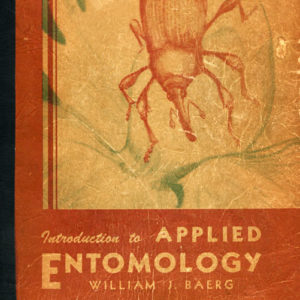 Applied Entomology by William Baerg
Applied Entomology by William Baerg  Black Widow Spider
Black Widow Spider 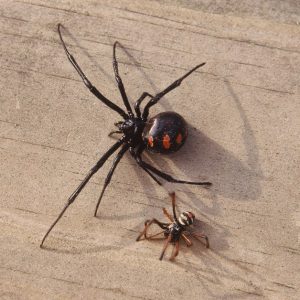 Black Widow Spiders
Black Widow Spiders 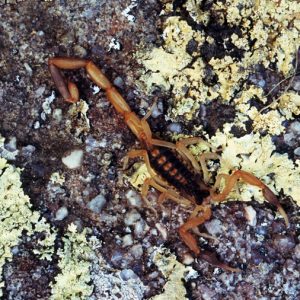 Striped Bark Scorpion
Striped Bark Scorpion  Tarantula
Tarantula  Tarantula Distribution
Tarantula Distribution 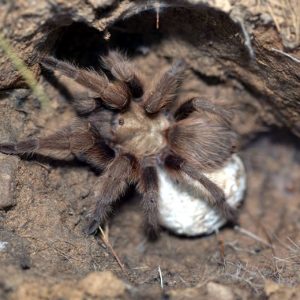 Tarantula with Egg Sac
Tarantula with Egg Sac  Tarantulas
Tarantulas 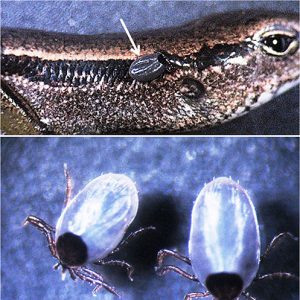 Ticks
Ticks 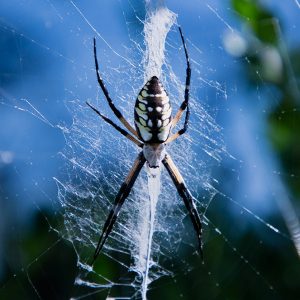 Yellow Garden Orb Weaver
Yellow Garden Orb Weaver 



Comments
No comments on this entry yet.